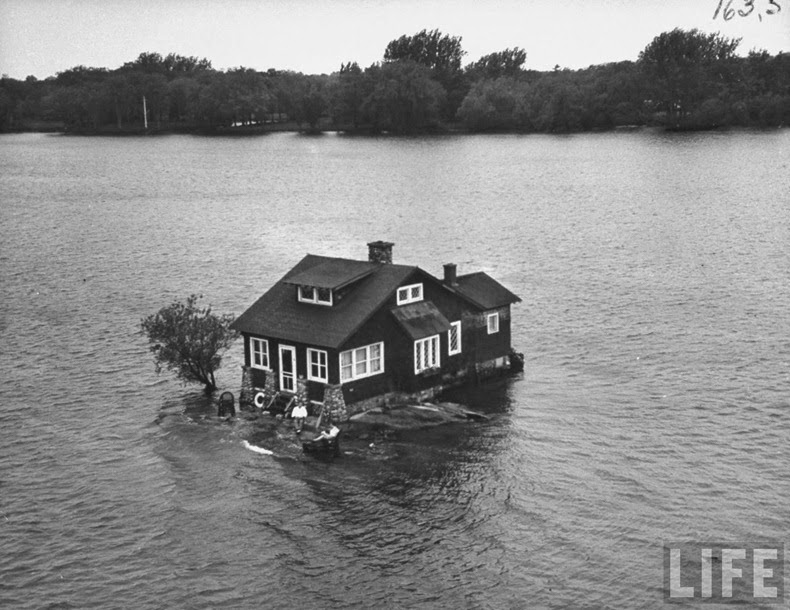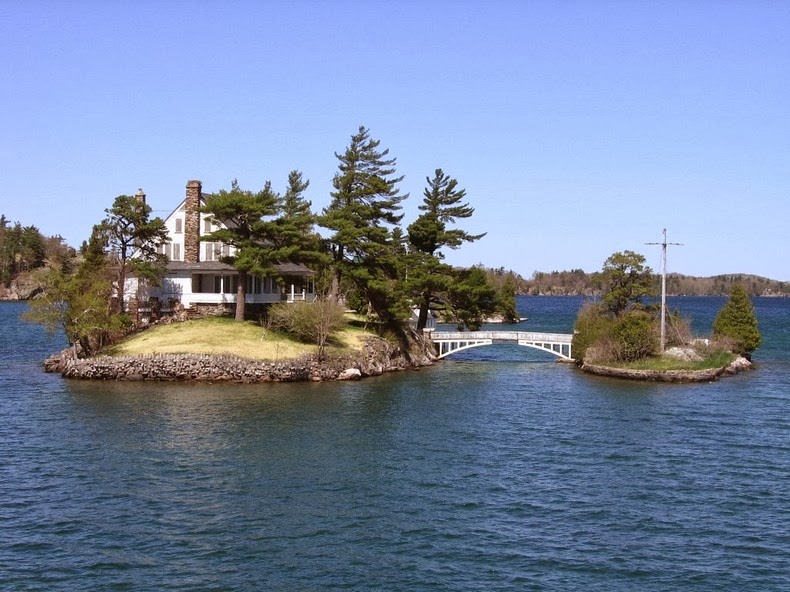The Thousand Islands is an archipelago consisting of exactly 1,864 islands that straddles the Canada-U.S. border in the Saint Lawrence River as it emerges from the northeast corner of Lake Ontario. They stretch for about 80 km on St. Lawrence Seaway, but the largest clustering of islands falls between Cape Vincent and Alexandria Bay in the United States and Kingston and Rockport in Canada. The islands range in size from over 40 square miles to smaller islands occupied by a single residence, to even smaller uninhabited outcroppings of rocks that are home to migratory waterfowl. The number of islands was determined using the criteria that any island must be above water level all year round, have an area greater than 1 square foot, and support at least one living tree.
The Just Room Enough Island. Photo credit
The largest of these islands is Wolfe Island which is about 29 km long and 9 km at its widest point. It has a resident population approximately 1400 people. By comparison, the very aptly named “Just Room Enough“ is the tiniest island that squeezes a single house and a couple of wrought-iron benches pushed hard up against the shingles onto its banks.
A large number of these islands are inhabited, often bearing a single and at times a tiny house, and are serviced by ferry boats from the mainland. Today most of the islands boast of having hydro electric power and telephone service being carried by underwater cable from island to island.
Around twenty of these islands form the Thousand Islands National Park, the oldest of Canada's national parks east of the Rockies. The park hosts campgrounds, inland walking trails, annual family events, as well as a national heritage building. The Thousand Islands-Frontenac Arch region was designated a World Biosphere Reserve by UNESCO in 2002.
Another view of Just Room Enough Island. Photo credit

An undated picture of Just Room Enough Island. Photo credit: Life.com
Aerial view showing some of the many islands of the Thousand Islands. Photo credit
Boldt Castle, located on Heart Island in the Thousand Islands. Photo credit
Photo credit: Ian Coristine

Source: Wikipedia, www.gananoque.com, Washingtonpost























Some of these home seem to be bad ideas. Wouldn't a structure which takes up an entire island, in a large body of water, be very susceptible to water damage, during a storm? I have seen photos and videos of storms on the Great Lakes, and the waves get quite large. It would seem that would put any dwelling built on an island which is so close to the normal water level in jeopardy.
ReplyDeleteMy thoughts exactly...
DeleteBut this is on the St. Lawrence River...not a big body of water like the Great Lakes.
DeleteIf one travels even further inland in Ontario one can access the Muskoka area, specifically the Parry Sound area, where there is an area referred to as the 30,000 Islands area.
ReplyDeleteIt's a boaters paradise, of which I've been blessed to participate in, and is one of the most beautiful areas in the world, albeit progressively overrun with people.
Muskoka is about as secluded as Manhattan; you need to go to northern Ontario (the REAL north, past North Bay).
ReplyDeleteThere is actually only two ferries- one from Cape Vincent, NY to Wolfe Island and one from Wolfe Island to Kingston, ON. The article makes it sound like there's a ferry service to and from all the islands. People use their private boats to "ferry" themselves back and forth.
ReplyDelete